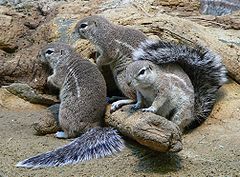Afrowiórki
| Xerinae[1] | |||
| Osborn, 1910[2] | |||
 Przedstawiciele podrodziny – afrowiórki namibijskie (Xerus inauris) | |||
| Systematyka | |||
| Domena | |||
|---|---|---|---|
| Królestwo | |||
| Typ | |||
| Podtyp | |||
| Nadgromada | |||
| Gromada | |||
| Infragromada | |||
| Rząd | |||
| Podrząd | |||
| Rodzina | |||
| Podrodzina | afrowiórki | ||
| Typ nomenklatoryczny | |||
| Plemiona | |||
| |||
Afrowiórki[3] (Xerinae) – podrodzina ssaków z rodziny wiewiórkowatych (Sciuridae).
Zasięg występowania
Rodzaj obejmuje gatunki występujące w Eurazji, Afryce i Ameryce Północnej[4][5].
Systematyka
Podział systematyczny
Do podrodziny należą następujące występujące współcześnie plemiona[4][3]:
Opisano również plemię wymarłe[6]:
- Sciurotamiini Kryštufek & Vohralík, 2012
oraz rodzaje wymarłe o niepewnej pozycji systematycznej:
- Palaeosciurus Pomel, 1853[7]
- Plesiosciurus Qiu & Liu, 1986[8]
- Protospermophilus Gazin, 1930[9]
- Sinotamias Qiu, 1991[10]
- Spermophilinus De Bruijn & Mein, 1968[11]
Przypisy
- ↑ Xerinae, [w:] Integrated Taxonomic Information System [online] (ang.).
- ↑ H.F. Osborn: The age of mammals in Europe, Asia and North America. New York: The Macmillan company, 1910, s. 535. (ang.).
- ↑ a b Nazwy zwyczajowe za: W. Cichocki, A. Ważna, J. Cichocki, E. Rajska-Jurgiel, A. Jasiński & W. Bogdanowicz: Polskie nazewnictwo ssaków świata. Warszawa: Muzeum i Instytut Zoologii PAN, 2015, s. 204–214. ISBN 978-83-88147-15-9. (pol. • ang.).
- ↑ a b C.J. Burgin, D.E. Wilson, R.A. Mittermeier, A.B. Rylands, T.E. Lacher & W. Sechrest: Illustrated Checklist of the Mammals of the World. Cz. 1: Monotremata to Rodentia. Barcelona: Lynx Edicions, 2020, s. 608–626. ISBN 978-84-16728-34-3. (ang.).
- ↑ D.E. Wilson & D.M. Reeder (redaktorzy): Subfamily Xerinae. [w:] Mammal Species of the World. A Taxonomic and Geographic Reference (Wyd. 3) [on-line]. Johns Hopkins University Press, 2005. [dostęp 2020-12-23].
- ↑ J.S. Zijlstra: Xerinae. Hesperomys project. [dostęp 2022-12-15]. (ang.).
- ↑ A.N. Pomel: Catalogue méthodique et descriptif des vertébrés fossiles découverts dans le bassin hydrographique supérieur de la Loire, et surtout de la vallée de son affluent principal, L’Allier. Paris: J.-B. Baillière, 1853, s. 17. (fr.).
- ↑ 邱铸鼎 & 林–璞/ Z.-d. Qiu & Y.-p, Liu. 江苏泗洪下草湾中中新世脊椎动物群 —5.松鼠科 (哺乳纲,嗤齿目)/ The Aragonian vertebrate fauna of Xiacaowan, Jiangsu—5. Sciuridae (Rodentia, Mammalia). „古脊椎动物学报 / Vertebrata PalAsiatica”. 24 (3), s. 202, 1986. (chiń. • ang.).
- ↑ Ch.L. Gazin. A Tertiary vertebrate fauna from the upper Cuyama drainage basin, California. „Carnegie Institution of Washington Publication”. 404, s. 64, 1930. (ang.).
- ↑ Z.-d. Qiu. The Neogene mammalian faunas of Ertemte andHarr Obo in Inner Mongolia (Nei Mongol), China—8. Sciuridae (Rodentia). „Senckenbergiana Lethaea”. 71 (3–4), s. 230, 1991. (ang.).
- ↑ Hand de Bruijn & P. Mein. On the mammalian fauna of the Hipparion-beds in the Calatayud-Teruel Basin (Prov. Zaragoza, Spain). Part V. The Sciurinae. „Proceedings of the Koninklijke Nederlandse Akademie van Wetenschappen”. Series B Physical Sciences. 71 (1), s. 84, 1968. (ang.).
Media użyte na tej stronie
Autor: (of code) -xfi-, Licencja: CC BY-SA 3.0
The Wikispecies logo created by Zephram Stark based on a concept design by Jeremykemp.

